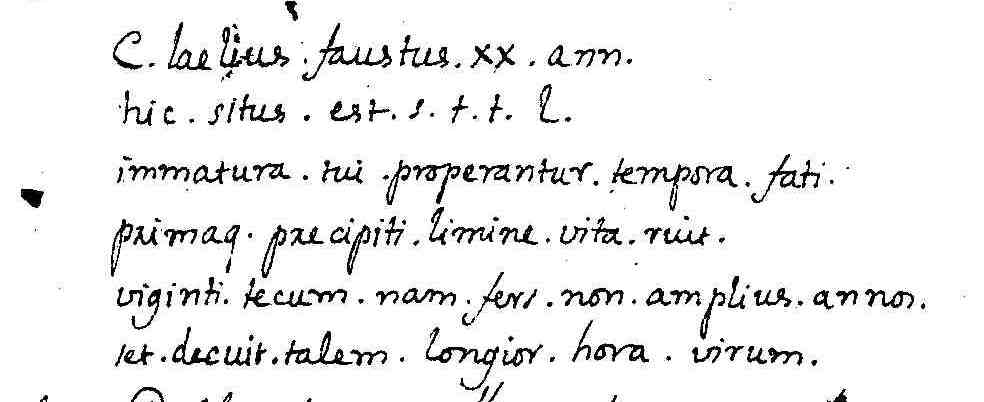SE17 Epitaph of Gaius Lellius Faustus
Reference CIL II2/5, 1055; CLE 1069 | Description | Lyrics | Location | Chronology | Epigraphic edition | Translation | Apparatus | Comentary | Type of verse | Text divided into verses and metric signs | Images | Bibliography | Link to DB | Author |
SE17 Epitaph of Gaius Lellius Faustus
Description
- Idno filename 22/01/0054
- Type of inscription: Sepulcralis
- Conservation status: There is no reason to suspect, as Hübner II 1413 does, that the top part was broken, since the text does not begin with C × L ×, but with C(aius) Laelius.
- Lost
Location
- Place of discovery: Found in Osuna, in the necropolis of Las Cuevas.
- Geolocation
- Location with Modern Nomenclature España / Sevilla / Osuna
- Location with Old Nomenclature Hispania / Baetica / Astigitanus / Urso
Chronology
- Inscription's dating: Between year 101 and year 199
- Dating explanation: It does not seem to be prior to the 2nd c. AD from the abbreviation ann, which is mostly documented from the 2nd c. González Fernández II2/5, 1055, dates it "ex formulis saec. II fere".
Type of verse
- Type of verse: Dactílico (dístico elegíaco)
- Verse/line correspondence: Si
- Prose/verse distinction: Si
Epigraphic edition
C(aius) ▴ Laelius ▴ Faustus ▴ XX ▴ ann(orum)
hic ▴ situs ▴ est ▴ s(it) ▴ t(ibi) ▴ t(erra) ▴ l(evis)
immatura ▴ tui ▴ properantur ▴ tempora ▴ fati ▴
primaq(ue) ▴ pr(a)ecipiti ▴ limine ▴ vita ▴ ruit ▴
5 viginti ▴ tecum ▴ nam ▴ fers ▴ non ▴ amplius ▴ annos ▴
set ▴ decuit ▴ talem ▴ longior ▴ hora ▴ virum
Text divided into verses and metric signs
Immatura tui properantur tempora fati ll|lkk|l/kk|ll|lkk|l~
primaque praecipiti limine vita ruit, lkk|lkk|l||lkk|lkk|~
viginti tecum nam fers non amplius annos, ll|l/l|l/l|l/l|lkk|l~
set decuit talem longior hora virum. lkk|ll|l||lkk|lkk|~
Translation
Gaius Laelius Faustus, of twenty years, is buried here; may the earth rest lightly on you. The times of your destiny rush on prematurely, and your life falls apart rapidly from its first threshold. For you take with you no more than twenty years; but a man such as you should have been awarded a more lasting hour .
Bibliography
FERNÁNDEZ FRANCO, s. XVI, ms. RAH, 9-6002-2/3 et 9-8073- 8, et BCC 59-2-6 et 59-6-27, sine foliorum numeris; VELÁZQUEZ, s. XVIII, RAH ms. 9/4118, 30c.; PONZ 1794, 144; ex eis HÜBNER II 1413 (inde BÜCHELER, CLE 1069, cuius exemplum in linguam Hispanicam vertit FERNÁNDEZ MARTÍNEZ 1998-99; CHOLODNIAK 1904, 1166; VIVES, ILER 5795; GONZÁLEZ FERNÁNDEZ, CILA II, 622; THIGPEN 1995, 330, quae in linguam Anglicam vertit [appendix 3, nº 22]); GONZÁLEZ FERNÁNDEZ, II2/5, 1055; PACHÓN ROMERO – RUIZ CECILIA 2006, 371–375; MARTÍN CAMACHO, CLEB ES, SE5, qui in linguam Hispanicam vertit; id. 2014, 147–159. – Cf. HÜBNER 1899, 350–351; HANFMANN 1951, vol. 1, 187; MARINER 1952, 89, 112; TELS-DE JONG 1959, 114; HERNÁNDEZ PÉREZ 2001a, 10, 15–16, 286; SALAS 2002, 34.
Apparatus
HÜBNER indicó que estaba fracturada al comienzo. – 1 C(aius) Laelius Fernández FRANCO, VELÁZQUEZ], C(ai) l(ibertus) PONZ, HÜBNER. – 4 primaque FERNÁNDEZ FRANCO, PONZ, HÜBNER, primaq VELÁZQUEZ; precipiti VELÁZQUEZ, PONZ, praecipiti FERNÁNDEZ FRANCO, HÜBNER; limine VELÁZQUEZ, PONZ, HÜBNER, limite FERNÁNDEZ FRANCO. – 5 set FERNÁNDEZ FRANCO, VELÁZQUEZ, sed PONZ, HÜBNER; longior FERNÁNDEZ FRANCO, VELÁZQUEZ, HÜBNER, longiore PONZ (con error tipográfico).
Comentary
Correct elegiac distichs. Ll. 3-4, topos of the mors immatura, cf. CLE 165,2; CLE 172,7. Ll. 5-6, statement from the dedicant that the deceased should have lived longer. Careful execution in the arrangement of elements: L. 3. immatura…tempora… and …tui…fati, versus aureus and alliteration of t, r, p; Ll. 4 and 6. prima…vita… / …precipiti limine… and…talem…virum / …longior hora… L. 4 might contain a double hypallage, where primaque precipiti limine vita ruit would be in place of primoque praeceps limine vita ruit (vid. Hernández Pérez 2001a, 15), from the loci simile, it can be undoubtedly deduced that the expressions similar to prima vita (prima iuventus, prima aetas), are usually in the ablative; praeceps, with a verb such as ruere, which is usually used predicatively (cf. Luc. 7,331 y 337; Mart. 11,82,2; or Verg. Aen. 11,673 and 12,684-85); and limine primo, with parallels both in epigraphical poetry and elsewhere, cf. Verg. Aen. 6,427-429: infantumque animae flentes in limine primo / quos dulcis vitae exsortis et ab ubere raptos / abstulit atra dies et funere acerbo (and from it CLE 567,4; CLE 569,3; CLE 1385,12 and also Stat. silv. 4,2,13 and 5,3,72-74; Luc. 2,106-107 y Sen. Herc. F f.1132-1134). The age of the deceased fits perfectly in the hexameter (cf. Fernández Martínez 1999b).
Author
- Author:J. Martín Camacho
- Last Update2024-02-25 19:12:14
You can download this






